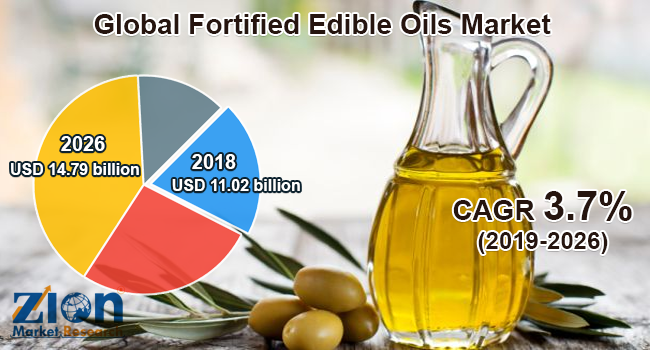Zion Market Research has published a new report titled “Fortified Edible Oils Market by Product Type (Palm Oil, Soybean Oil, Sunflower Oil, Olive Oil, Corn Oil, Canola Oil, Rice Bran Oil, and Others), by Micronutrient (Vitamin A, Vitamin D, Vitamin E, and Others), and by Distribution Channel (Hypermarkets/Supermarkets, B2B, E-Commerce, Specialty Retail, and Others): Global Industry Perspective, Comprehensive Analysis, and Forecast, 2018–2026”. According to the report, the global fortified edible oils market accounted for USD 11.02 billion in 2018 and is expected to reach USD 14.79 billion by 2026, growing at a CAGR of 3.7% between 2019 and 2026.
Edible oils are enhanced with added micronutrients and are known as fortified edible oils. These oils contain an appropriate concentration of different vitamins like Vitamin A, D, and E, among others. These oils are mostly manufactured and consumed to curb the problem of undernourishment. Thus, these have been gaining importance across the world over the last few years.
The increasing vitamin deficiency issues like vitamin A deficiency (VAD) due to the busy lifestyles of the people, which is driving the sales of fortified edible oils. Moreover, the growing number of collaborations between public and private companies for curbing malnutrition by launching different fortified oils is also boosting the fortified edible oils market. However, fortified edible oils are priced a little higher than normal edible oils, which may act as a restraint for the fortified edible oils market.
The global fortified edible oils market is fragmented based on product type, micronutrient, and distribution channel. By product type, the market includes rice bran oil, sunflower oil, palm oil, soybean oil, corn oil, olive oil, canola oil, and others. Soybean oil currently holds the largest market share, due to its various health benefits. Olive and canola oils are also showing substantial growth potential in the market, owing to the increasing health-consciousness of consumers. Rice bran oil is expected to witness the highest CAGR over the projected time period.
By micronutrient, the global fortified edible oils market is divided into vitamin A, D, E, and others. Vitamin A dominates the market, due to it being more deficient among the common masses. This segment is expected to dominate the market in the future as well. This demand can be attributed to the increasing diseases caused by lack of vitamin A, such as xerophthalmia. Vitamin D and E are expected to show substantial growth in the years ahead.
On the basis of the distribution channel, the market comprises B2B, specialty retails, hypermarkets/supermarkets, e-commerce, and others. Hypermarkets/supermarkets dominate the market, as they rank at the top in terms of consumer preference for their tangibility. In the e-commerce segment, online sales have shown substantial growth in recent years due to its convenience.
The Middle East and Africa and Latin America dominate the global fortified edible oils market, owing to these oils prominence in various regional cuisines. This domination is expected to continue over the estimated timeline as well. Europe and North America are expected to show substantial growth rates, due to the growing preference for healthy food ingredients that helps in the overall health improvement.
Some key players in the fortified edible oils market are Bunge Limited, Ruchi Soya Industries, Conagra Brands, Archer Daniels Midland, and Adani Wilmar.
Global Fortified Edible Oils Market: Product Type Analysis
- Palm Oil
- Soybean Oil
- Sunflower Oil
- Olive Oil
- Corn Oil
- Canola Oil
- Rice Bran Oil
- Others
Global Fortified Edible Oils Market: Micronutrient Analysis
- Vitamin A
- Vitamin D
- Vitamin E
- Others
Global Fortified Edible oils Market: Distribution Channel Analysis
- Hypermarkets/ Supermarkets
- B2B
- E-Commerce
- Specialty Retail
- Others
Global Fortified Edible oils Market: Regional Analysis
- North America
- The U.S.
- Europe
- UK
- France
- Germany
- Asia Pacific
- China
- Japan
- India
- Latin America
- Brazil
- The Middle East and Africa
